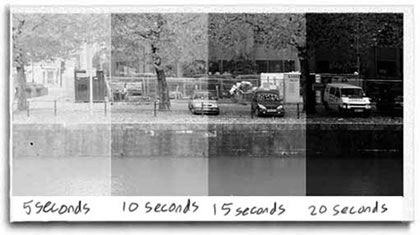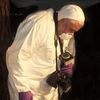Infrared processing
May 14, 2013 22:58:46 #
I have been trying to work with Rollie infrared film. My negatives turn out fine, I adjust the ASA down from 400 to 50 and use an infrared dark filter. When it's time to print, I just get a black print I make a test strip first with the lens set at everything from 2.0 to 16. So, I was wondering if anyone has some tips to share? I was thinking my next step would be to try with a filter on the enlarger. Other than that, I have read several books on infrared, but I was disappointed that none of them talks about developing they just explain the basic steps from film loading to filters.
May 15, 2013 08:22:54 #
hfb
Loc: Northwestern Louisiana
After development it is a normal negative. If you can see images on the negative then it should print. Black on the paper means no light. I would keep adding time to the paper exposure until you get a good print. All this is assuming you have made prints and developed negatives before and understand the film to print process.
May 15, 2013 10:47:09 #
hfb wrote:
After development it is a normal negative. If you can see images on the negative then it should print. Black on the paper means no light. I would keep adding time to the paper exposure until you get a good print. All this is assuming you have made prints and developed negatives before and understand the film to print process.
Black on the paper means an abundance of light, white on the paper means no light. It is light that turns the paper black!
May 15, 2013 10:49:11 #
fhayes wrote:
I have been trying to work with Rollie infrared fi... (show quote)
Maybe the paper you are using has been 'fogged' i.e. accidentally exposed to light?
May 15, 2013 11:28:16 #
Hi Peter,
No the paper is fine, I use it for regular prints as well.
I just don't get that no matter what setting, it's the same black, like obsidian. I have tried all openings on the lens and test strips that range as low as one second to twenty seconds. I know I am doing something wrong, just cant put my finger on it.
No the paper is fine, I use it for regular prints as well.
I just don't get that no matter what setting, it's the same black, like obsidian. I have tried all openings on the lens and test strips that range as low as one second to twenty seconds. I know I am doing something wrong, just cant put my finger on it.
May 15, 2013 11:30:16 #
fhayes wrote:
Hi Peter,
No the paper is fine, I use it for regular prints as well.
I just don't get that no matter what setting, it's the same black, like obsidian.
No the paper is fine, I use it for regular prints as well.
I just don't get that no matter what setting, it's the same black, like obsidian.
If it comes out black, you are overexposing, assuming there is an image on the negative to print.
Are you sure you mixed the developer correctly?
Not sure of your experience level, but as a beginner, I found something like this to be handy:
http://www.adorama.com/DKPPS.html
May 15, 2013 12:10:09 #
GoofyNewfie, I like the chart! I am using regular B&W print developer, is there something different I should be using?
Thanks for the tip!
Thanks for the tip!
May 15, 2013 12:12:19 #
fhayes wrote:
GoofyNewfie, I like the chart! I am using regular B&W print developer, is there something different I should be using?
Thanks for the tip!
Thanks for the tip!
Can you print a regular negative and get a good print from your set-up, using what's in the tray now?
May 15, 2013 12:25:49 #
May 15, 2013 12:35:31 #
fhayes wrote:
yes I can, no problem with a regular print.
Cut the time and/or stop down more.
I miss my darkroom- (but not the chemicals).
It was more magical to see an image come up in the tray than "chimping" on the LCD.
Test strips?
I never adjusted the aperture to make a test strip- only the time. Got this sample off the web. (http://shorecrestphoto.blogspot.com/2012_03_01_archive.html)
It was made with several 5 sec exposures, gradually uncovering the paper for each exposure.

May 15, 2013 12:49:20 #
I have cut the time, to one second. Even changed the aperture across the dial 2 to 22. I mixed the developer myself. Eventually, I will crack this and live happily ever after!
May 15, 2013 12:53:48 #
fhayes wrote:
I have cut the time, to one second. Even changed the aperture across the dial 2 to 22. I mixed the developer myself. Eventually, I will crack this and live happily ever after!
After all youv'e done, the only thing I can think of is that the negative is so underexposed as to be almost clear. This would certainly account for black sheets of paper. Sory I can't help further.
May 15, 2013 13:06:08 #
Peter Boyd wrote:
After all youv'e done, the only thing I can think of is that the negative is so underexposed as to be almost clear. This would certainly account for black sheets of paper. Sory I can't help further.
Same thoughts here.
I didn't do that much infrared film and never shot with Rollei film (Cameras, yes, film, no). Is there less density in the base compared to "normal" film?
May 15, 2013 13:15:08 #
From what you are saying the neg must be totally transparent or "thin".this means that you are under exposing the neg or under developing it. Does the manufacturers details appear on the processed film? If the answer is yes then you are developing it ok if not then no. Kodak high speed ir film used to dev in D76/hc110 for about 13 mins at 20 C if my memory serves me correctly. The IR transmitting filter will cut about six stops from your exposure which you will have to compensate for. I have no knowledge of Rollei IR film I thought they only made equipment.
May 15, 2013 15:46:44 #
If you want to reply, then register here. Registration is free and your account is created instantly, so you can post right away.



